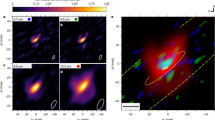Abstract
THE presence of dust around normal (main-sequence) stars is a possible signature of the early stages of planet formation. Scattered light from the star β Pictoris provides evidence of a dust disk extending out to about 1,000 astronomical units1, and the observation of far-infrared excess emission from several other main-sequence stars2 suggests the presence of orbiting cold dust grains3. Because the dynamical lifetime of this dust is short, it is thought to be supplied and replenished by collisions among a population of comets or asteroids4–8. Observations by Chini et al. 9,10 of β Pic and several other infrared-excess stars at a wave-length of 1.3 mm have supported the idea that they are surrounded by extended dust disks. Techniques developed recently now permit imaging at these wavelengths, and we have used these techniques to obtain a map of the dust disk around the nearby, prototypical infrared-excess star Fomalhaut with a spatial resolution of 80 au. This image provides direct confirmation that the dust is distributed in a disk-like structure, and shows that the structure extends about 200 au from the star, farther than estimated previously9,10. We estimate that a high rate of cometary and/or asteroidal collisions is required to maintain this disk.
This is a preview of subscription content, access via your institution
Access options
Subscribe to this journal
Receive 51 print issues and online access
$199.00 per year
only $3.90 per issue
Buy this article
- Purchase on Springer Link
- Instant access to full article PDF
Prices may be subject to local taxes which are calculated during checkout
Similar content being viewed by others
References
Smith, B. A. & Terrile, R. J. Science 226, 1421–1424 (1984).
Aumann, H. H. et al. Astrophys. J. 278, L23–L27 (1984).
Backman, D. E. & Paresce, F. in Protostars and Planets III (eds Levy, E. & Lunine, J. I.) 1253–1304. (Univ. of Arizona Press, Tucson, 1993).
Weissman, P. R. Science 224, 987–989 (1984).
Harper, D. A., Lowenstein, R. F. & Davidson, D. A. Astrophys. J. 285, 808–820 (1984).
Stern, S. A. Icarus 84, 447–466 (1990).
Zuckerman, B. & Becklin, E. E. in Submillimetre Astronomy (eds Watt, G. D. & Webster, A. S.) 147–153 (Klüwer, Dordrecht, 1993).
Zuckerman, B. & Becklin, E. E., Astrophys. J. 414, 793–802 (1993).
Chini, R., Krugel, E. & Kreysa, E. Astr. Astrophys. 227, L5–L11 (1990).
Chini, R., Krugel, E., Shustov, B., Tutokov, A. & Kreysa, E. Astr. Astrophys. 252, 220–228 (1991).
Kreysa, E., Lemke, R., Haslam, C. G. T. & Sievers, A. W. Astr. Astrophys. (in the press).
Griffin, M. J. et al. Icarus 65, 244–258 (1986).
Orton, G. S. et al. Icarus 67, 289–301 (1986).
Gillet, F. C. in Light on Dark Matter (ed. Israel, F. P.) 61–69 (Reidel, Dordrecht, 1986).
Aumann, H. H. in The Infrared Spectra of Stars (Pergamon, New York, 1990).
Weintraub, D. A. & Stern, S. A. Astr. J. (submitted).
Hildebrand, R. H. Q. JI. R. astr. Soc. 24, 267–282 (1983).
Sandell, G. & Weintraub, D. A. Astr. Astrophys. (submitted).
Sykes, M. V. et al. in Asteroids II (eds Binzel, R. P., Gehrels, T. & Matthews, M. S.) 336–368 (Univ. of Arizona Press, Tucson, 1989).
Green, E. M., Demarque, P. & King, C. R. The Revised Yale Isochrones and Luminosity Functions (Yale Univ. Obs., New Haven, 1987).
Stern, S. A. & Stewart, G. R. Bull. Am. Astr. Soc. 26, 1064 (1993).
Stern, S. A. & Stewart, G. R. Icarus (submitted).
Haslam, C. T. G. Astr. Astrophys. Suppl. Ser. 15, 333–350 (1974).
Salter, C. J. IRAM Preprint No. 84 (Institut de Radio Astronomie Millimétrique, Grenoble, 1986).
Author information
Authors and Affiliations
Rights and permissions
About this article
Cite this article
Stern, S., Festou, M. & Weintraub, D. A map of a collisionally evolving dust disk around Fomalhaut. Nature 368, 312–314 (1994). https://doi.org/10.1038/368312a0
Received:
Accepted:
Issue Date:
DOI: https://doi.org/10.1038/368312a0
This article is cited by
-
Observations of disks around Main Sequence stars (? Pictoris)
Astrophysics and Space Science (1995)
-
Correction: A map of a collisionally evolving dust disk around Fomalhaut
Nature (1994)
-
A circumsolar ring of asteroidal dust in resonant lock with the Earth
Nature (1994)
-
As planets go by
Nature (1994)
Comments
By submitting a comment you agree to abide by our Terms and Community Guidelines. If you find something abusive or that does not comply with our terms or guidelines please flag it as inappropriate.



